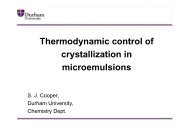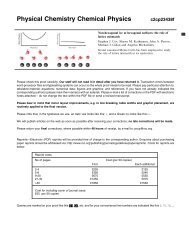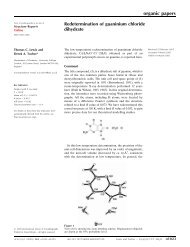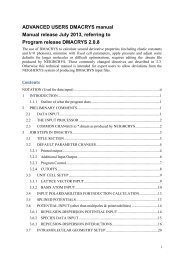An Introduction to the Theory of Crystalline Elemental Solids and ...
An Introduction to the Theory of Crystalline Elemental Solids and ...
An Introduction to the Theory of Crystalline Elemental Solids and ...
You also want an ePaper? Increase the reach of your titles
YUMPU automatically turns print PDFs into web optimized ePapers that Google loves.
44<br />
2<br />
Shockley<br />
Energy (eV)<br />
0<br />
-2<br />
-4<br />
-6<br />
-8<br />
Tamm<br />
-10<br />
<br />
FIG. 23: Surface projected bulk b<strong>and</strong> structure for a 12 layer Cu(111) slab as computed from a<br />
plane-wave pseudopotential DFT calculation within <strong>the</strong> LDA (computed by <strong>the</strong> authors).<br />
solutions <strong>of</strong> <strong>the</strong> Schrödinger equation which would o<strong>the</strong>rwise be imaginary in <strong>the</strong> bulk<br />
<strong>to</strong> become real in <strong>the</strong> semi-infinite crystal. Shockley states appear close <strong>to</strong> <strong>the</strong> low<br />
energy (i.e., high binding energy) border <strong>of</strong> a gap <strong>and</strong> reveal a free-electron-like behavior<br />
parallel <strong>to</strong> <strong>the</strong> surface. A particularly well characterized Shockley state is <strong>the</strong> one that<br />
occurs on Cu(111). According <strong>to</strong> ARPES this is a free electron-like state which at<br />
<strong>the</strong> Γ point <strong>of</strong> <strong>the</strong> surface Brillouin zone resides ∼ 0.4 eV below E F [173, 174]. DFT<br />
calculations agree with this finding, as can be seen from <strong>the</strong> computed b<strong>and</strong> structure<br />
<strong>of</strong> Cu(111) shown in Fig. 23. The Shockley state can be seen at <strong>the</strong> Γ point just below E F .<br />
(b) Tamm states: These are characteristic <strong>of</strong> more tightly bound systems such as <strong>the</strong><br />
transition metals in which <strong>the</strong> valence electrons are d states. Tamm states are split-<strong>of</strong>f<br />
states due <strong>to</strong> <strong>the</strong> reduced a<strong>to</strong>mic coordination <strong>of</strong> <strong>the</strong> surface <strong>and</strong> <strong>the</strong> weaker potential<br />
that arises (which was discussed in section 7.2). They reside also at <strong>the</strong> low energy<br />
border <strong>of</strong> gaps <strong>and</strong> <strong>of</strong>ten exhibit negative effective masses. Noble metal surfaces such as<br />
Cu(111) also exhibit Tamm states (in addition <strong>to</strong> Shockley states) <strong>and</strong> indeed in Fig. 23<br />
an occupied Tamm state 1.8 eV below E F can be seen at <strong>the</strong> M point split <strong>of</strong>f from<br />
<strong>the</strong> <strong>to</strong>p <strong>of</strong> <strong>the</strong> Cu d b<strong>and</strong>. Again <strong>the</strong> computed value <strong>of</strong> this surface state agrees with<br />
experiment [175, 176].<br />
Finally we mention yet one more type <strong>of</strong> state that can occur at metal surfaces, <strong>the</strong>se<br />
are so-called image potential states which are localized mostly in <strong>the</strong> vacuum region <strong>of</strong><br />
<strong>the</strong> metal surface (Fig. 22(d)). Recall from section 7.1 how <strong>the</strong> image potential rises <strong>to</strong><br />
<strong>the</strong> vacuum level V ∞ as one moves out from <strong>the</strong> surface in<strong>to</strong> <strong>the</strong> vacuum (Fig. 19(b)).<br />
This potential can actually support unoccupied bound states, i.e., image potential states.<br />
These states lie above <strong>the</strong> Fermi energy, in a Rydberg-like series <strong>of</strong> states converging<br />
<strong>to</strong>wards <strong>the</strong> vacuum level. Should such image potential states become populated with<br />
electrons <strong>the</strong>se states can have relatively long lifetimes. The reader interested in learning<br />
more about image potential states, in particular, <strong>and</strong> surface states, in general, should<br />
consult <strong>the</strong> book by Davison <strong>and</strong> M. Stȩślicka [161] or some <strong>of</strong> <strong>the</strong> excellent reviews on<br />
<strong>the</strong>se <strong>to</strong>pics [164, 177, 178].







